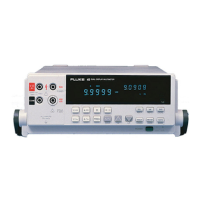Option -05 IEEE-488 Interface
Troubleshooting
8
8-11
If the IEEE-488 Interface Option is not detected by Fluke 45 software, there may be a
problem with the OPS or ACON* signal. The IEEE Interface Option grounds the OPS
signal (A5P2-18), which is normally pulled up to VCC on the Fluke 45 Main Assembly.
The Microprocessor determines that the IEEE-488 Interface Option is not installed if
OPS (A1U6-29) is detected high.
Further, software does not allow the IEEE-488 Interface Option to be selected if the
ACON* signal is detected high. Since ACON* is high when the meter is operating on
battery power, the IEEE-488 Interface Option cannot be selected as the active interface
during battery operation. The displayed "IEEE" message is dim, and the battery indicator
blinks if the Fluke 45 software detects ACON* to be high when the option editor is
entered. The ACON* signal (A1U6-33) is low when the meter is operating from line
power.
8-18. Failure to Handshake on IEEE-488 Bus
Check VCC2 with a voltmeter. When the Fluke 45 is operating on line power, VCC2
should be about 0.1V lower than VCC. VCC2 is controlled by the Microprocessor,
which sets A1U6-28 high when operating on line power and causes OPTSW* to be
driven to a -5.0V dc level. The OPTSW* signal controls the gate of FET switch A5Q1
on the IEEE-488 Interface Option to turn VCC2 on.
The Reset circuit consists of A5CR1, A5R1, A5U2, and A5U9. When the meter is
operating on batteries, the Reset circuit converts the OPTSW* signal to a digital signal
that disables access to A5U6. When operating from batteries, OPTSW* is at about 5.0V
dc, A5U2-9 is high, A5U2-10 is low, and A5U9-9 is low to reset A5U6 via pin 22.
When the meter is connected to ac line voltage again, this circuit resets A5U6. OPTSW*
transitions to -5.0V dc, A5U2-9 is low (near GND), A5U2-10 is high, and A5U9-9 stays
low until the Address Decoder detects a memory access to the IEEE-488 Interface
Option. About 1.0 ms after OPTSW* goes to -5.0V dc, the initial read access clocks
A5U9-11, causing A5U9-9 to go high to remove the reset from A5U6-22. This action is
followed by another "dummy" read cycle for delay. The Main Assembly then sends six
write cycles to initialize A5U6. The IRQ2 interrupt is then enabled, and the serial poll
status byte is initialized. At this point, the IEEE-488 Interface Option is ready to respond
to transactions on the IEEE-488 bus.
Note
Each time that the IEEE Interface Option is selected in the BAUD menu
(by pressing [AUTO]), the IEEE-488 Interface Option initialization is
repeated as described above, with the exception that no hardware reset is
performed via the OPTSW* signal.
8-19. Failure to Enter Remote
If the IEEE-488 Interface Option does not enter remote, check that the remote/local
control circuit is operating properly. When the IEEE-488 Interface Option is the active
instrument interface, the remote/local control state is polled by the Main PCA
approximately every 1.0 ms. Normally, A5U5-8 goes low for approximately 1.0 µs
during the read cycle that checks the state of A5U6. If A5U3-11 is low during the read
cycle, A5U6 is in the local state. If A5U3-11 is high during the read cycle, A5U6 is in
the remote state. When A5U6 indicates that it is in remote, the REMOTE indicator on
the display is turned on.

